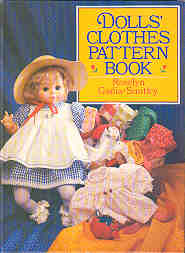
HISTORY OF THE DOLL
Copyright (1987): Roselyn Gadia-Smitley
Reprinted With Permission from: Dolls' Clothes Pattern Book
Publisher: Sterling Publishing Co., Inc., NY
387 Park Avenue South, New York, NY 10016

The origins of the doll have been traced back by historians to religious rites of primitive societies. Historians further speculate that as beliefs faded, the importance of the doll waned. As a result, the dolls were handed down to children as toys. Evidence of the link between the doll and religious rites is supported by ancient Greek literature, in which girls were observed making clothing for their dolls and offering these valued playthings to the nymphs or to Artemis at the time of their engagement for marriage. Further evidence was noted by Boehn, a historian, on the practice of the Hopi Indians who, at the conclusion of ceremonial rites, gave the dolls to the children to play with.
The earliest samples of European dolls dated from the fourteenth century in Nuremberg, Germany. These dolls were modeled after children, monks, and women, dressed in the fashion of the time. One notable characteristic of these dolls was a circular hollow in the breast. It has been speculated that these cavities may have been designed to hold a christening gift, such as a florin. Archaeologists noted the existence of similar dolls in diggings, which indicated that these dolls were made in multiple numbers. These discoveries indicated that the doll industry was a thriving enterprise at this time.
Listings of dollmaker names in the city records of Nuremberg were dated as early as the fifteenth century. During this period, guilds of dollmakers were also established in the city, which regulated the types of dolls made and the methods of distribution of these dolls by peddlers.
An actual specimen of a doll made in the 1500's was found in 1966 in a Rhenish castle, giving us a glimpse of the period dolls of this time. This nine-inch doll was described by Hillier, a historian, as one carved in limewood and embellished with colored paint. The doll wore a tightly bodiced linen dress, which extended to the neckline, held in place with gold embroidery. A matching embroidered wide stomacher was worn over the girdle of the dress. The doll wore a net cap, with rounded points, which was drawn down to the side, over her ears. It can be noted that dolls dated in the 1500s bear testimony to the costume period when compared to the paintings of this time.
Fashion dolls became popular around the 1300's. Court records noted events such as the gifts of fashion dolls sent by the French queen to the queen of England in 1321. Another event that was noted was when Isabeau of Bavaria, queen of France, sent dolls to England from France to show the newest French fashions in 1391. In essence, the task of popularizing French fashions abroad was carried on by the doll.
To far-reaching colonies, such as North America, Parisian dolls were sent to illustrate the current Parisian fashions and to serve as the dressmaker's model as well. An advertisement of the New England Weekly Journal of July 2, 1733 read as follows:
" At Mrs. Hannah Teatt's, dressmaker at the top of Summer Street, Boston, is to be seen a mannequin, in the latest fashion, with articles of dress, night dresses, and everything appertaining to women's attire. It has been brought from London by Captain White. Ladies who choose to see it may come or send for it. It is always ready to serve you. If you come, it will cost you two shillings, but if you send for it, seven shillings."
It can be noted that these fashion dolls were exempted from embargoes even at the time of wars during the 1300's to the 1800's.
The practice of sending costume dolls to other countries remained popular until the emergence of the hand-colored fashion plates. Fashion magazines such as The Lady's Magazine, Entertaining Companion for the Fair Sex, Polite Depository of Amusement and Instruction, The Lady's Monthly Museum, and Instruct the Mind and Exalt the Character of the British Fair all enjoyed popularity late in the 1700's. These magazines became the major source of fashion information for the ladies of the time. The magazines gradually replaced the fashion dolls as the means of fashion communication between countries.
This website: https://chip-smitley.tripod.com/historyofthedoll.htm
For continuation of page content on the doll industry in Europe and the United States, click at this link: Next Page-2
For continuation of page content: with "Barbie"-size doll patterns, click at this link: Next Page-3
For additional information, click at these links:
| Collecting Barbie Dolls |
|
For retailers, click at these links: